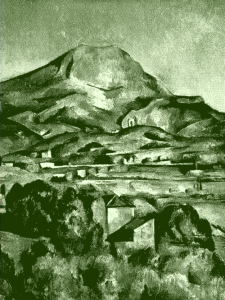Modernists, Mechanization and Momentousness
Cézanne and the illusory speed of industry
In the late 19th century, Paul Cézanne showed us that the world was not composed of a unified vantage point with a single and particular perspective of physical space and time. Instead, the world is replete with an endless set of places and times and our own sensibilities and perception are altered by the objects appearing before us. The shimmering light reflecting off the hills in a painting like La Montagne Sainte-Victoire (detail above) is not only a pictorial description of how those hills may have looked at the time that Cézanne saw them. The painting is also a means to describe the complexity of our relationship with the underlying reality of the world. Light moves forward and backward across hills and trees. Space is interrupted by clouds and leaves and by the paint itself. Time itself is pushed and pulled through the shadows on buildings, the highlights on trees and grass, and the brush strokes and the collapse of pigment upon itself.
The painting depicts a moment in time by calling attention to the painting of time itself.
When we view a relatively unspoiled environment in this painting, it is very easy to believe that we see what Cézanne saw in 1885. Before us is a landscape of possibilities with masses of objects clumped together made up of even smaller elements drafted in time. A slight turn of our painter’s head would change his (and our) perspective dramatically. The push and pull of color overlaps everywhere and sometimes all at once. Time speeds up and stands still and becomes momentarily transparent. In this way, the passage of time and the experience of visual space are both seen and unseen. Cézanne depicted perspective through perspective. And I would suggest that this was easier to do before the onset of industrialization and before landscapes were heavily modified by the age of machines and agriculture.
Pablo Picasso studied Cézanne diligently and later digested Cézanne’s depicted space replete with texture and subtlety. But Picasso was also forced to take everything one step further. By the early 20th century, landscapes in Europe were becoming increasingly divided into countries, provinces, cities, towns and counties through roads, farms, factories and layers of industry. Machines dominated the experience of environment — and our vision adapted.
Early modernists like Picasso would offer up a very different means of viewing the world. Speed and agility and transportation split the landscape into an ever diminishing system of pieces, tightly connected yet sprawling and impossible to tie together in the way that Cézanne could. Futurist Filippo Tommaso Marinetti called it: “A new beauty has been added to the splendor of the world — the beauty of speed.”
By 1908, Picasso and Georges Braque had together fully reified Cézanne’s vision of nature with their slivers and slices of form, inducing what would become a new visual modernity. In those few fell swoops, Picasso and Braque brought us Cubism, a description of a natural world that sacrifices a totalizing perception of the natural landscape, depicting what we now call the built environment. Their planes of light and colour were no longer reflections of the world that once was; instead, their paintings are meditations on the mechanization that will be (and is today). Picasso and Braque’s early Cubist paintings of people, landscapes and objects show a refracted vantage point from the eyes of a subject now in the maw of the machine.
A few years later, painters like Stuart Davis showed us what the world looks like again, this time flattened. Many of his paintings showed the American natural environment, divided into shapes, sections and sub-sections that reflect a more fully populated environment segmented by industry, cities, suburbs and agriculture. For Davis, the natural world is no longer natural; the landscape is demarcated by lines and lines are segmented by colour. His paintings add up to a panoply of shapes that only represent a built environment that is whole because we made it so.
Unlike our friend Cézanne, Davis records a landscape that is sectioned, cordoned, halved, quartered and eighthed. It is a paint-by-numbers world, cordoned off, segmented and striated. And to a very large extent, it is the world that most of us experience right now.
And yet, we might remember that Cézanne’s pre-industrial landscape is still there. Underneath the division and dissection of the land and the totalizing presence of modernity, there is an earth united and indivisible. It’s there, beneath everything, and findable if we make the time.
